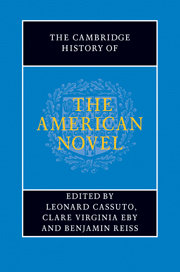Book contents
- Frontmatter
- General Introduction
- PART ONE INVENTING THE AMERICAN NOVEL
- PART TWO REALISM, PROTEST, ACCOMMODATION
- PART THREE MODERNISM AND BEYOND
- Introduction: modernism and beyond
- 37 Stein, Hemingway, and American modernisms
- 38 The Great Gatsby and the 1920s
- 39 Philosophy and the American novel
- 40 Steinbeck and the proletarian novel
- 41 The novel, mass culture, mass media
- 42 Wright, Hurston, and the direction of the African American novel
- 43 Ellison and Baldwin: aesthetics, activism, and the social order
- 44 Religion and the twentieth-century American novel
- 45 Faulkner and the Southern novel
- 46 Law and the American novel
- 47 Twentieth-century publishing and the rise of the paperback
- 48 The novel of crime, mystery, and suspense
- 49 US novels and US wars
- 50 Science fiction
- 51 Female genre fiction in the twentieth century
- 52 Children's novels
- 53 The American novel and the rise of the suburbs
- 54 The Jewish great American novel
- 55 The Beats and the 1960s
- 56 Literary feminisms
- 57 Reimagining genders and sexualities
- PART FOUR CONTEMPORARY FORMATIONS
- A selected bibliography
- Index
53 - The American novel and the rise of the suburbs
from PART THREE - MODERNISM AND BEYOND
Published online by Cambridge University Press: 28 July 2011
- Frontmatter
- General Introduction
- PART ONE INVENTING THE AMERICAN NOVEL
- PART TWO REALISM, PROTEST, ACCOMMODATION
- PART THREE MODERNISM AND BEYOND
- Introduction: modernism and beyond
- 37 Stein, Hemingway, and American modernisms
- 38 The Great Gatsby and the 1920s
- 39 Philosophy and the American novel
- 40 Steinbeck and the proletarian novel
- 41 The novel, mass culture, mass media
- 42 Wright, Hurston, and the direction of the African American novel
- 43 Ellison and Baldwin: aesthetics, activism, and the social order
- 44 Religion and the twentieth-century American novel
- 45 Faulkner and the Southern novel
- 46 Law and the American novel
- 47 Twentieth-century publishing and the rise of the paperback
- 48 The novel of crime, mystery, and suspense
- 49 US novels and US wars
- 50 Science fiction
- 51 Female genre fiction in the twentieth century
- 52 Children's novels
- 53 The American novel and the rise of the suburbs
- 54 The Jewish great American novel
- 55 The Beats and the 1960s
- 56 Literary feminisms
- 57 Reimagining genders and sexualities
- PART FOUR CONTEMPORARY FORMATIONS
- A selected bibliography
- Index
Summary
The suburb has been an important setting and subject of the American novel since the 1920s, with its ascendance as the residential environment of choice for the white middle class. Until recently, the suburban novel has received little attention from literary scholars; analysis of canonical American literature has focused instead on the wilderness and the frontier, on the isolated landscapes and folkways that are the province of regionalism, and on the cities that ground realism and modernism as well as ethnic and African American writings. One of the earliest treatments of the suburb in literature established the terms on which it could be discounted. In “The Great American Novel” (1927), Edith Wharton lamented her fellow writers’ preoccupation with “the little suburban house at number one million and ten Volstead Avenue.” Wharton noted the “material advantages” such a house provided but deplored the spiritual and aesthetic deficiencies of “the safe and uniform life” found within it. A poor stimulus for “the artist's imagination,” it helped to foster the “middling,” “middle class” existence that writers purported to condemn. The suburban literary tradition has flourished in spite of Wharton's effort to derail it; indeed, her essay did not so much describe an existing literature as provide a blueprint for it. The suburban novel continues to privilege analysis and assessment and to focus on the banal, the mediocre, and the conventional, even as the suburbs themselves have radically changed.
- Type
- Chapter
- Information
- The Cambridge History of the American Novel , pp. 879 - 892Publisher: Cambridge University PressPrint publication year: 2011
- 1
- Cited by



